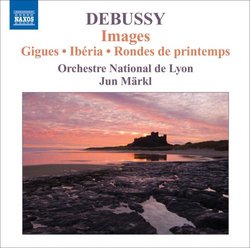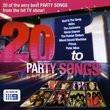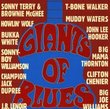| All Artists: Debussy, Orchestre Nat'l De Lyon, Markl Title: Images for Orchestra 3 Members Wishing: 0 Total Copies: 0 Label: Naxos Original Release Date: 1/1/2010 Re-Release Date: 3/30/2010 Genre: Classical Style: Symphonies Number of Discs: 1 SwapaCD Credits: 1 UPC: 747313229673 |
Search - Debussy, Orchestre Nat'l De Lyon, Markl :: Images for Orchestra 3
 | Debussy, Orchestre Nat'l De Lyon, Markl Images for Orchestra 3 Genre: Classical
|
Larger Image |
CD DetailsSimilar CDs
|
CD ReviewsDebussy (V. 3): Images + Orch Music: ONL, Jun Markl: Crystal Dan Fee | Berkeley, CA USA | 04/11/2010 (5 out of 5 stars) "This disc is the most recent release of three discs now published.
One readily anticipates Naxos finishing a complete set, filled out with lesser known Debussy plus orchestrations, played by these same excellent musical forces. This third volume is all about the orchestra suite called Images. Gigues starts the scenarios off, followed by three sections of the longer Iberia, rounded up by the Rondes de printemps. The remainder is orchestrations of smaller Debussy works by the composer himself, and by famous colleague Maurice Ravel. One might recall this cluster of delicious moments like an old EMI disc of short pieces under Sir Thomas Beecham with the Royal Philharmonic Orchestra, called aptly, Bon-bons. Our band is Orchestre National de Lyon, or ONL. Our conductor is the young German, Jun Markl. Right from this third disc's beginning tracks, we know the special excellence of this series just keeps on giving. The ONL departments do themselves proud, and sound to be fully engaged with the music, as with their leader Jun Markl. The regional-folk music flavors of the Images, especially in the three Iberia sections of the middle work in the set, are vivid and flavorful - though not, one hastens to add, offering up readings which go against the overall interpretive gains already noted in discs one and two. That is to say, still: this band under this conductor have a decidedly modern or post-modern take on what makes Debussy tick. The music is played with festive, subtle inflections, yet all is grounded in great, burning clarity of textures, kept together by irrepressible forward motion. We can still hear plenty of tone color from the band departments on this third disc (as was brilliantly true of discs one and two), especially from the woodwinds; but all is etched, fiery, crystalline. This music happens in all its details revealed, as well as in its constantly shifting and developing intuitive forms. For once, vivid colors do not mean any neglect of how phrasing mirrors musical narrative flow, all path-breaking and innovative. Even the bon-bons may stun a listener as more of an abstract, sculpted sound-shape in moving time, than as passing sweets, in Late Romantic salon fashion. Played like this, the four filler pieces come off akin to etudes, rather more so than not, despite the fact that they are a grab-bag whose orchestrations were shared by Debussy and Ravel. Ravel did two, the Sarabande and the Danse; Debussy did two, the Marche ecossaise sur un theme populaire, and that encore-like piano piece, La plus que lente. The best way to get all this is just to spin this volume on the player, as many already have done for the first two volumes from Naxos. Markers in the recorded catalog to suggest what ONL and Markl accomplish? Well, maybe one could imagine a combination of the rhythm and headlong motion we associate with Toscanini or Charles Munch on existing discs. Then add the sharp transparency in orchestra music we might associate with George Szell in Cleveland, or Pierre Boulez. And finish off with just the right touches of glitter and warmth of tone colors we associate with, say, Jean Martinon's complete Debussy readings? Markl's genius with the ONL inhabits a strikingly elevated musical realm, gone altogether brilliant and sensuous and diaphanous still - altogether cooler in big musical picture objectivities, though far, far from cold, unmoved, unmoving. Indeed, these readings are so exalted that surely high resolution fans must loudly lament our lack of an SACD multichannel disc to further immerse oneself aurally in the bending and swooshing of colors and lights, even though distinctively cooler, even though still a tad greater in abstractions and Debussy essences. Given the etched hand that guides these three discs so far, a listener may be reminded of the Third Vienna School, and especially of Anton Webern. Never has Debussy sounded less rambling, or come across more heart than head, capturing his immersions in the real world of the human senses. Markl and ONL are still emphasizing the contrapuntal, as if Debussy knew and drew upon more from our medieval polyphonist-baroque heritage than most of us modern-eared listeners might realize. Indeed, so far: all the disc's readings open up such musings about forebears and continuities of deeper musical intellect. On this third disc, rhythms are subtly sprung, and the overall sense of fire and clarity continues lighting our path. The relentless finesse may seem to have more to do with the fractal ratios of Nature revealed, or the mysterious observational vagaries of quarks than with an older, post-Romantic Debussy still ambling along at its own pace, into harder-later Modernity. Whew. The recorded competition is stiff for the Images, particularly. Dutoit with Montreal, Haitink in Amsterdam, Charles Munch in Boston, Martinon in Paris ... tops names, top readings, all. Plus ... Boulez, Tilson Thomas in Boston, and the redoubtable-resurrected Inghelbrecht on Testament. Lots, then, for competition. You could almost shut your eyes and grab one, without necessarily getting a really terrible performance. Okay. Add this one to the end of the keeper list, ranked higher rather than lower. Sound is very good for regular red book CD stereo. I do not know what the engineering difficulties of the ONL hall in France may be, but if they exist at all, they have been well enough resolved by the recording team. For this third disc, sound is still no detriment. Compared to the former Naxos catalog readings of Debussy, this series stands tall, indeed. Even heard against the rest of the catalog, too? When music gets this good in a Naxos series, I have trouble staying focused on that review task of making fine distinctions between the top top and the nearly top top. Just enjoy this Debussy, and check out the first two Naxos Debussy discs, too, by this conductor and the Lyon band." |

 Track Listings (9) - Disc #1
Track Listings (9) - Disc #1

